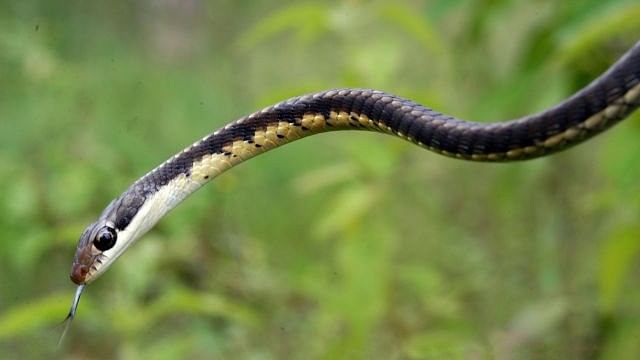
Dendrelaphis tristis.
Credit: Wikimedia commons
One warm morning at Navilu Kaadu, a curious creature decided to pay us a visit at the cottage — a common bronzeback tree snake (Dendrelaphis tristis). Other than the green vine snake (Ahaetulla nasuta), I’d never seen a snake as slender or one so quick. The reptile panicked when it sensed us. It slithered about furiously looking for an escape.
We tried to guide it towards the door, but the anxious snake kept retreating further into the house. Our older one was asleep in the bedroom, and we were wary of the snake making its way into the room, lest the boy and the snake startle one another.
The shimmery snake tried scaling the walls of the cottage with swift, graceful leaps. It was about four feet long, with a copper sheen on the dorsal side and cream-hued flanks and underbelly. Unlike most snakes with icy, hypnotic eyes, this little snake had large cartoonish anime-style eyes on an elongated head. The common bronzeback can be distinguished from other bronzeback species by the white spot on its head, something I failed to notice in the shindy.
How did this tree-dwelling snake end up in a human abode? At the time, we had a luxuriant Mysore clock vine growing on the trellis bordering the yard and a violet allamanda on the eastern flank. The common bronzeback, being an arboreal species, must have snuck onto the metal pipes propping up the awning over our yard from one of the vines, and crept into the cottage. We eventually coaxed the reptile out of the house without incident.
Common bronzebacks are endemic to South Asia and widely distributed throughout India (Whitaker 1978). They are diurnal (active during the day). And like the Indian wolf snake (Lycodon aulicus) I wrote about in my previous column, common bronzebacks too belong to Colubridae, the largest and most diverse snake family. They have venom in their rear fangs to incapacitate prey, though harmless to humans.
Bronzebacks are swift and alert snakes. They are skilled hunters too. Rather than expend precious energy pursuing prey, they prefer to hunt by stealth, like all ambush predators or ‘sit-and-wait’ predators. They skulk about in tree canopies, their tan bodies blending in with the foliage, and strike unsuspecting prey with lethal precision. They relish skinks, birds, geckos and frogs. When threatened, common bronzebacks inflate their necks to reveal blue interscales in a show of aggression.
It isn’t easy keeping food and foe in your line of vision when you are a snake known for speed. But common bronzebacks are endowed with keen eyesight and gyroscopic heads. This means the orientation and position of these snakes’ heads remain unchanged, relative to the ground. Which then means, their vision isn’t hampered by their swift, slithering body movements.
With no limbs to help them grip, common bronzebacks rely entirely on prehensile tails to ensure they don’t fall out of trees while going about their day. Many tree-dwelling creatures, including primates, are endowed with prehensile tails to grasp boughs and support their body weight, as they negotiate perilous heights in tree canopies.
If we humans were bestowed with a similarly marvellous appendage, it would indubitably end up as a gadget holder!
Male bronzebacks duel to win themselves a beautiful lady. A mated female lays up to eight eggs. Tree hollows and leaf litter make for cosy bronzeback nurseries. The young are precocial and fend for themselves soon after hatching, quickly acquiring both hunting and hiding prowess as they grow.
Like all snakes, these too moult or shed their skin, keeping parasites at bay, and retaining a healthy, supple, and glossy outer layer. Their dainty looks work against them though, as they are victims of illegal pet trade and are coveted for their glossy skin.
Common bronzeback snakes play a crucial role in keeping their prey numbers in check. They are food for other snake species, birds of prey and mongooses. They are sensitive to changes in their environment. Hence their presence indicates a healthy and balanced ecosystem, which then makes Navilu Kaadu a common bronzeback-certified balanced ecosystem!
Rooting for Nature is a monthly column on an off-kilter urban family’s trysts with nature on a natural farm.
The author chipped away at a software marketing career before shifting gears to sustainable entrepreneurship and natural farming. She posts as @ramyacoushik on Instagram. Reach her at bluejaydiaries@gmail.com